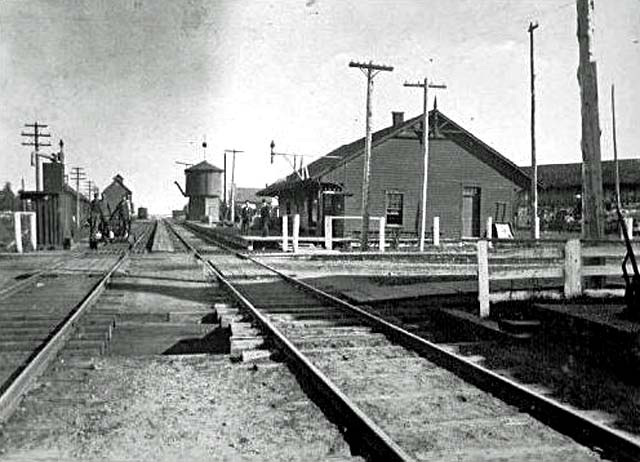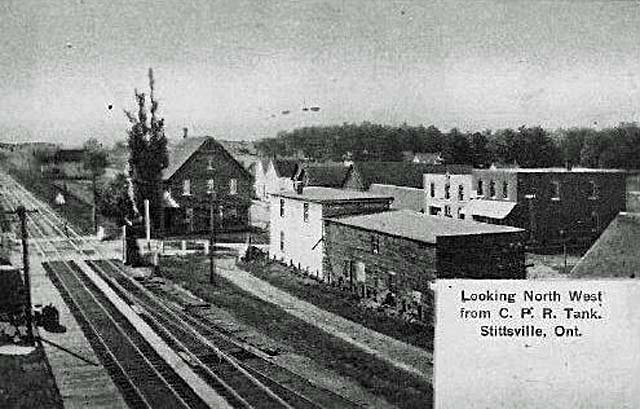|


This photograph shows Stittsville's railway complex around 1895, with what is now Stittsville Main Street crossing
the tracks in the foreground. It shows the original railway station that was situated near the street, with the water tower in the distance. A new station was
built a little further east where the station building is now located at Village Square Park in present-day Stittsville - Circa 1895 Photographer unknown.
3 January 2013
Trains Pass Through Stittsville
for 120 Years
Stittsville Ontario - Wednesday, 16th of September is a date of significance in Stittsville's history.
It is particularly important in the community's railway history as 16 Sep 1870 was the day when the first train steamed along the newly built line and past the
newly constructed Stittsville railway station at the site of what is now Village Square in downtown Stittsville. The rail line from Ottawa to Carleton Place
followed the route which is now the Trans-Canada Trail.
This would mark the beginning of 120 years of railway service through the community, ending on 14 Jan 1990 when a westbound VIA passenger train swept through
the village on its way to the west coast. This was the last day of train traffic through Stittsville as railway crews started ripping up the track the very
next day.
Of course, the Stittsville railway station, once the hub of community life, had been long gone by the time this last train passed through Stittsville. The
railway station had been demolished in 1969, just one year shy of the 100th anniversary of the first train service to the community.
Imagine what it must have been like on 16 Sep 1870 when the first train, suitably decorated for the occasion, passed through Stittsville? This was the newest
and latest form of travel and what an improvement over the horse and buggy age that had predominated local transportation up until that time.
The Canada Central Railway, which built the line from Ottawa to Carleton to link up to its existing line from Brockville to Carleton, was taken over by the
Canadian Pacific Railway in 1882, which retained ownership until the track was removed in 1990 and the right-of-way was eventually sold to the then regional
government of Ottawa-Carleton, eventually becoming the Trans-Canada Trail.
In any case, on 16 Sep 1870, the first scheduled train to run along the track came steaming along from Ottawa, headed for Carleton Place. This first train
involved eight coaches, pulled by a powerful steam locomotive named H.H. Abbott after the contractor who had built the rail line. The engine apparently was a
sight to behold with its shining steel jacket, brass trimmings, its wooden fittings painted bright red, and all decked out with Union Jack flags and red,
white, and blue bunting. Yes, to be standing at the Stittsville station and watch the arrival and departure of this celebratory first train would have been a
memorable day to be sure.
This first train was passing through Stittsville and Goulbourn just a month after the disastrous Carleton County Fire of 1870 had leveled much of the
surrounding land, killing two people in the Stittsville area and destroying many buildings. Indeed, the railway line under construction had been used to
transport water in barrels from the Mississippi River at Carleton Place to Goulbourn, carrying 40 barrels per trip. In addition, railway workers scurried about
the countryside, helping local farmers battle the quickly advancing blaze. It all helped but this blaze, later known as the Great Fire, destroyed everything in
its path and only some quick thinking in releasing a dam at Dow's Lake in Ottawa prevented the fire from consuming Ottawa as well.
The Great Fire destroyed much of Stittsville which was at the time centred in the area of what is now the Carp Road between Hazeldean Road and Stittsville Main
Street. When Stittsville rebuilt, much of it happened not at the former location but in the vicinity of the new railway station which emerged as the heart of
the village as the years went on and train traffic increased. Hotels and stores sprung up around the railway station, forever changing the hub of the
village.
An extensive system of tracks came to be established at Stittsville, with switches and sidings, as the railway became the vehicle by which local farmers got
their produce to market.
The rail line also served passenger traffic, with many travelling from Stittsville to either Ottawa or Carleton Place for shopping, school, visiting, or work.
Mail was carried by the trains as well as freight of all kinds.
Up to eight trains a day passed through Stittsville at one time. The station was a busy, busy, spot, made even busier when the Canadian Pacific Railway
completed its cross-Canada telegraph line in 1886, adding Canada-wide telegraph services to its offerings at its stations including Stittsville.
While the new railway line brought lots of joy on that September day in 1870, and resulted in much daily activity throughout the years, the rail line did bring
tragedy as well.
In 1898, early on a foggy October morning just east of Stittsville, a westbound freight train collided head-on with a train from Toronto. Two of the train crew
died and several were injured. Both locomotives were so badly damaged that they were written off. Fortunately none of the passenger cars were overturned
although the passengers were shaken up.
Two years later, in 1900, an 18-year-old girl, daughter of James Butler who built the three storey red brick hotel that now houses Hudson Insurance at the
corner of Stittsville Main Street and Abbott Street, fell in front of a slow moving engine and was killed.
As the years went by, the train remained a transportation staple for the Stittsville and Goulbourn community, although the coming of the automobile and its
increasing popularity did influence train travel. The construction of a provincial highway through Stittsville in 1922, crossing the track right at the railway
station, was a sign of the growing use and popularity of the automobile. However, during the years of World War II, troop trains were a common sight along the
rail line.
However, after World War II, the growing popularity of automobiles brought about a gradual decline in train traffic, eventually leading to the discontinuation
of local rail service and the removal of the train station in the late 1960's.
Rail traffic was to continue for another two decades until that day in January, 1990, when the last train passed through, ending 120 years of train travel
through Stittsville.
John Curry.

This scene shows the railway track system in Stittsville sometime before 1911. On the far right Mann's store is
visible at the corner of Abbott Street and Main Street which burned down in 1911. The railway station's platform can be seen at the left while the three storey
brick building which is now the home of Hudson Insurance at the southwest corner of Abbott and Main can be seen in the centre of the scene - Date/Photographer
unknown.



Vancouver Island
British Columbia
Canada
|